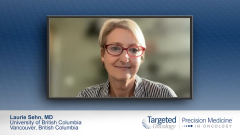
Follicular Lymphoma Workup: What is the Role of PET Imaging?
A brief review of the role that PET imaging plays in staging follicular lymphoma and how it may inform treatment decisions.
Episodes in this series

Transcript:
Matthew J. Matasar, MD: One area of investigation that caught my interest is in looking at the use of functional imaging with PET [positron emission tomography] scans to potentially inform decision-making, with literature suggesting that patients whose follicular lymphoma is more highly FDG [fluorodeoxyglucose]-avid perhaps deriving incremental benefit from anthracycline-based chemo-immunotherapy as opposed to the more frequently applied bendamustine, as you’ve already said, which we often prefer because of its toxicity profile. Is this something that you’ve thought about incorporating into your practice?
Laurie Sehn, MD: I think PET scanning has turned out to be a very valuable tool for follicular lymphoma. When we first started incorporating PET scanning into our staging and response assessment for lymphomas, most of us felt that it was going to be most valuable in the curative entities to make sure that we’ve seen a complete response in the end. But it’s proven to be very valuable primarily because it is a very sensitive test for detecting follicular lymphoma. So I think it has value in a number of ways. It has allowed us to refine staging for those patients who kind of sit on the fence between limited-stage and advanced-stage disease. It has helped to clarify that in some of our patients where we maybe would have taken an involved-field radiation therapy route, it’s clear that that’s not the way to go, and this is more of an advanced-stage patient. So I think it has allowed greater sensitivity in staging patients.
Can it distinguish between an aggressive or an indolent B-cell lymphoma? To a certain degree. There is a correlation between the PET avidity, often measured with the objective scale of the SUV, or standardized uptake value, where the higher the SUV, the more concerning it would be for an aggressively behaving lymphoma. I think when some of the early data had come out, it had been established that perhaps an SUV score of 12 or higher was much more indicative of possibly an occult transformed lymphoma or an aggressive lymphoma. But I think that experience has borne out, and from some of the studies that have built in PET scanning routinely, we see that there’s a much wider variation between patients with follicular lymphoma with PET uptake. So I don’t think there’s an easy cutoff that will allow us to distinguish transformation or no transformation, for example. I think this can increase our concern for transformation, then maybe direct biopsies at those areas, or look more closely at that patient to try to distinguish whether or not we’re dealing with a side by side transformation, but there’s no absolute cutoff I would say is appropriate to use in the clinic to make an absolute distinction.
The question you raised is really interesting. Assuming the patient has only follicular lymphoma, can you use the degree of uptake on a PET scan to suggest which patients might have more biologically aggressive disease and would perhaps benefit from a more cytotoxic appropriate regimen for aggressive lymphomas, like R-CHOP [rituximab, cyclophosphamide, hydroxydaunorubicin hydrochloride, vincristine, prednisone] vs BR [bendamustine, rituximab]? To be honest, I don’t think that there’s data right now to definitively guide us in that way.
In my own clinic, while I do do PET scans prior to therapy as part of standard staging, I think it can help guide toward ruling out a transformation, but would it help me to select actual therapy if I was convinced the patient didn’t have underlying transformation? I just don’t think we have the data to say that, for example, R-CHOP is going to be better than BR in that setting. And I’m always concerned about using R-CHOP without a valid reason. So we do know that there’s no data to say that R-CHOP will improve survival over a different chemotherapy if used upfront for follicular lymphoma, but we do know that it certainly offers more toxicity for most patients. Many of our patients are older in age, and I’m most concerned about what happens when that patient does transform in the future if I’ve already used up that anthracycline opportunity. So I’m not so sure we can use the PET scan to guide us in that fashion.
Transcript edited for clarity.










































